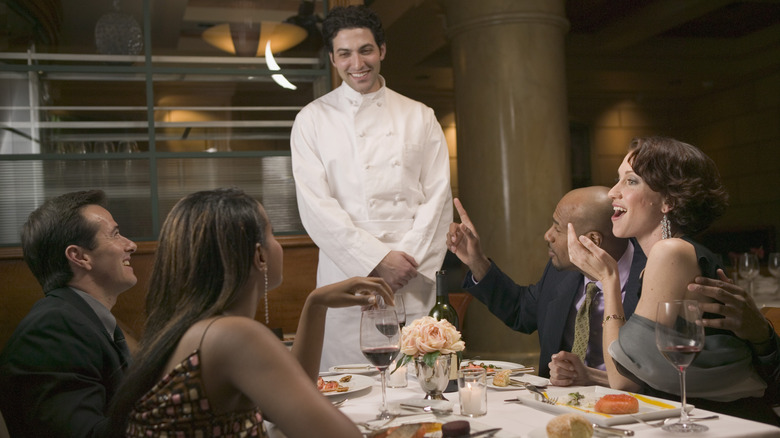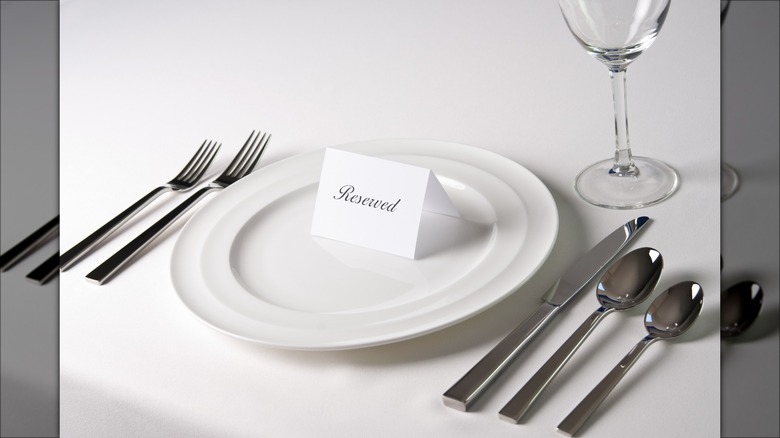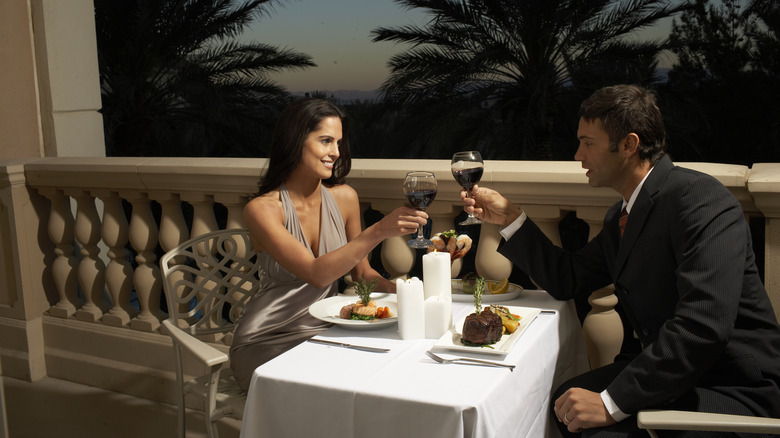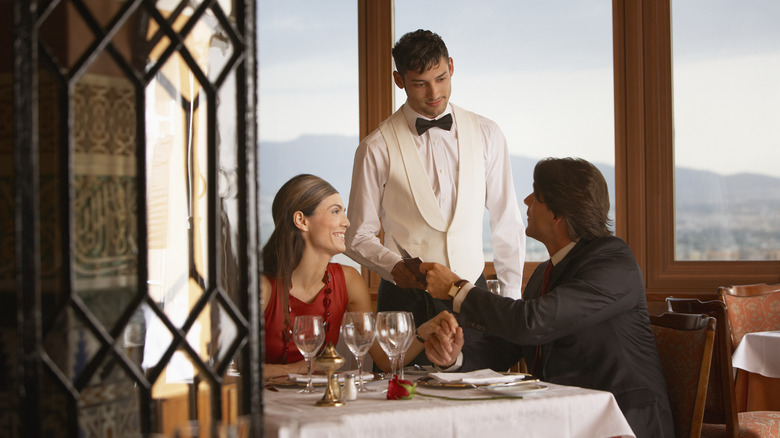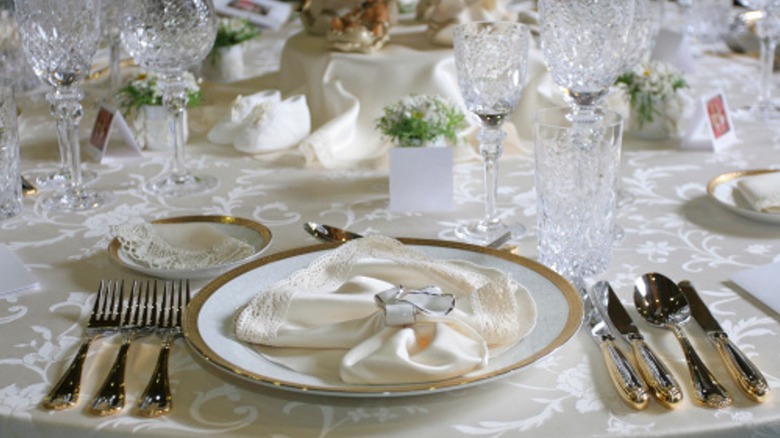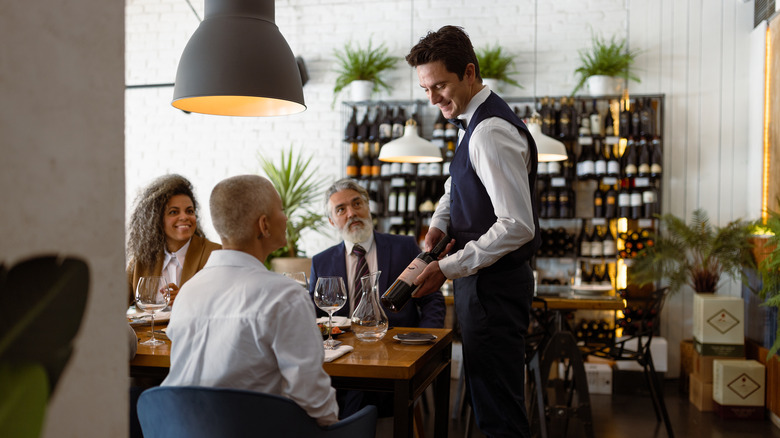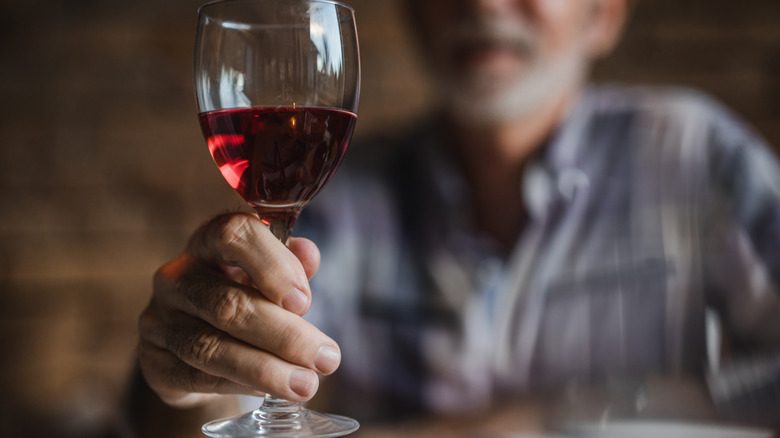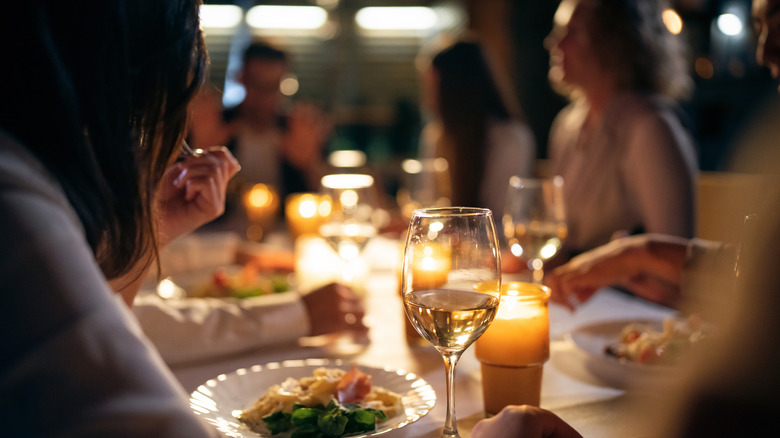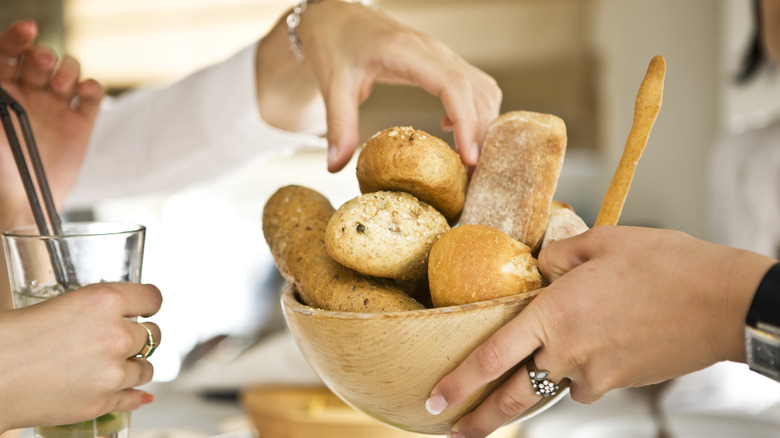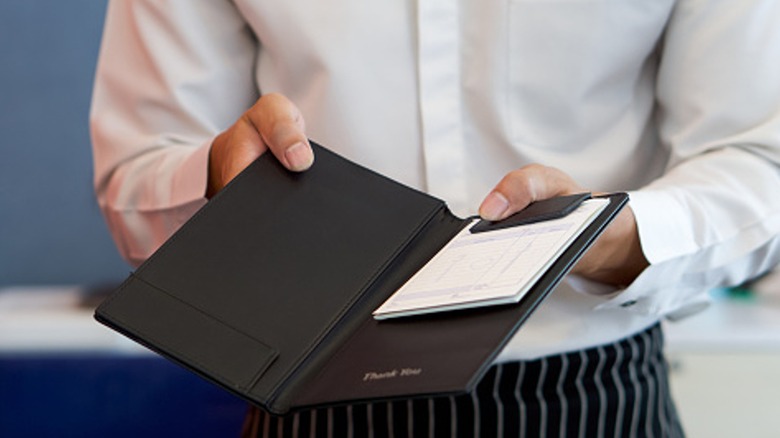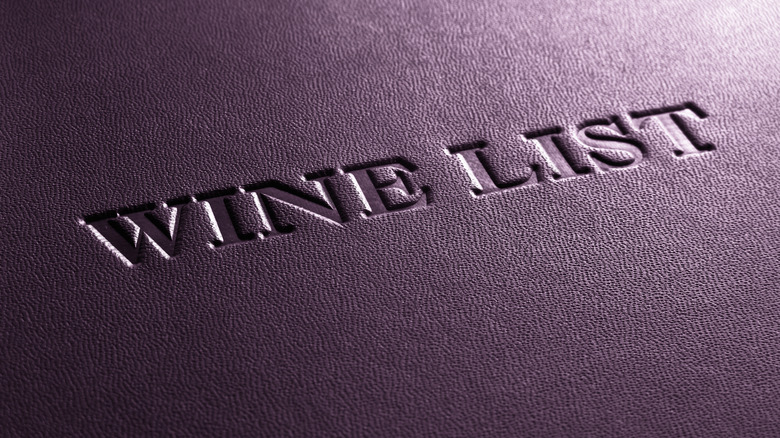Read This Before Ordering At A Fine Dining Restaurant
Planning a lunch or dinner out at a fine dining restaurant can be very exciting. The prospect of tasting four-star quality food in elegant surroundings is not something many of us get to experience every day. However, while you may be feeling excited about your upcoming reservation — whether it is with friends or family — you may also be feeling a bit nervous. After all, fine dining establishments are quite different from your average burger joint or family restaurant. The rules when ordering and eating your meal aren't going to be the same.
If you're worried about making a mistake and using the wrong fork for your salad, ordering something off of the menu that you won't like, or spending too much for a fancy meal or bottle of wine, you've come to the right place. In the next few sections, you'll find several tips to help you push the stress aside and thoroughly enjoy your next (or possibly first) fine-dining experience.
Make a reservation and arrive on time
If you're planning on eating at a fine dining restaurant, be sure to call ahead and make a reservation. Many of these establishments are more likely to be busy and may not have availability if you just walk up and ask to be seated. If you're planning to go on a holiday where there are likely to be more potential patrons, such as Father's Day or Easter, or eating with a large group, making a reservation is even more important, and you should try to make it as far in advance as possible.
Beyond helping ensure that you're able to eat at the restaurant you're planning on, making a reservation is also important for the restaurant staff. When you make a reservation, they'll be able to have your table set and ready for you. You'll also be able to get seated more quickly upon arrival. Many restaurants allow patrons to make reservations through their website or through apps such as OpenTable, while others may require you to call in and speak with a staff member.
Dress appropriately
Dressing appropriately is very important when dining at a fancy restaurant. You don't want to be under-dressed and show up in a pair of jeans and a t-shirt. However, the exact dress code for each restaurant can vary. Start by looking at the company's website to see if they include information about their dress code. You may find one of the following categories listed: casual, business casual, casual elegant, formal, or jacket required.
There are a few recommendations to keep in mind when dressing for each category. A casual dress code at a nice restaurant will likely not match your definition of casual for lounging on the weekend. Instead, look for polo shirts, fitted slacks or jeans, skirts or dresses, leather boots or shoes, etc. Business casual would imply a more professional style of dressing, including suits, collared shirts, and skirts. As you edge into the casual elegant, formal, or jacket-required categories, the demand for nicer clothing increases. The jacket required category represents the highest level. As the name implies, men are required to wear a jacket, but women are also expected to be dressed in formal clothing, such as an evening gown.
Be kind and courteous to the staff
Whether you will be eating at a fine dining restaurant for the first time or the hundredth time, it is always important to treat the staff with kindness and respect. There is no need to be rude or order them around, regardless of the situation. Keep in mind that they are working hard to make a living and that they are likely waiting on several other tables. While your request for a glass of wine or the dessert menu may feel urgent to you, they may be handling something equally or even more urgent for another customer.
How you treat the hostesses, serves, and other restaurant employees will also send your guests and others in the restaurant a message about you. They'll judge your character based on how you react to delays, wrong orders, and other potential mishaps. Just remember to stay calm and be considerate. Now, that doesn't mean that you should let huge errors completely slide. If you are receiving horrible service or don't feel that your server has adequately addressed a concern, you can ask to speak to the manager. Just do so without creating a huge scene, and remain reasonable during your discussion with the server.
Brush up on where each piece of silverware goes and what it is for
While you won't have to set the table when you dine out (phew!), you will need to know how to use the different plates, bowls, and utensils that are set at your spot. For more casual restaurants, you'll likely have just a dinner fork, a dinner knife, and a soup spoon at your spot, with the dinner fork on the left side of the plate and the knife and spoon on the right.
However, if you're eating at a very fancy restaurant, you may sit down to find a formal dinnerware setting in front of you. With this setup, you could be staring down at about 10 utensils and several plates. Despite how overwhelming the setup can look, the general rule is to start with the forks and spoons that are furthest from the plate and work your way in as you go through the meal. For example, the salad fork will be the furthest on the left of the plate, while the dinner fork will be just to the left of it. If you're unsure, follow the lead of another diner in your group.
Ask your server and sommelier for recommendations
Trying new dishes is one of the exciting things about dining at a fancy restaurant. Beyond their elegant appearance, these places are typically known for having expert chefs who prepare exceptional cuisine. Don't be afraid to ask your server for recommendations. They should be able to tell you some of the dishes that the chef is known for or even share their own experiences with tasting different items from the menu.
The dinner menu isn't the only thing that can look overwhelming when you're eating in a fine-dining restaurant. You may also feel lost looking over the wine menu. Here is another time when you don't want to be afraid to ask for suggestions. The restaurant you're dining at may have a sommelier that can help you navigate the various options. A sommelier is someone with a lot of professional wine knowledge. They will be able to ask you a few questions about what you like in a bottle of wine and offer some suggestions that will suit your palate. The sommelier can also offer suggestions for which wines would pair best with the entrée or dessert you've selected.
Learn the proper way to hold a wine glass
In addition to knowing which pieces of cutlery to use, you should also make sure you know how to properly hold a wine glass before heading to a fancy restaurant. Holding the glass in the wrong way could make you appear rude or uncivilized. If you didn't know that there was even a right and wrong way to hold a wine glass, well, now you do.
When holding a stemmed wine glass, your hand should be almost all the way down at the base of the glass. Hold the stem in between your forefinger, middle finger, and thumb, which will leave your ring finger and pinky finger resting on the base. Not only will holding the glass in this fashion show that you know what you're doing, but it will also help ensure that the wine in the glass stays cooler. Instead of wrapping your warm hands around the bowl of the wine glass and heating up the liquid it holds, your hand will be further away, helping everything stay cool.
Remember your table manners
While using proper table manners should be a given in any dining situation, many of us are used to a more relaxed and less formal meal. However, before eating in a fine dining establishment, you'll want to give yourself a quick refresher on proper dining etiquette and table manners. First, always use your silverware, even for items you might pick up to eat at home or in a more casual restaurant. Many of us talk using our hands, but you will want to avoid "talking" with your utensils. Keep them positioned near your plate and avoid pointing around or gesturing using them. You should also remember to place your fork, knife, or spoon down on your plate before you pick up your glass of wine or any other beverage to take a drink.
Once you sit down at the table, place the napkin on your lap and leave it there throughout the meal. If you need to get up to use the restroom, you can either put the napkin on the seat of the chair or fold it neatly and place it on the left side of your plate. Avoid blowing on food to cool it. Either way, a few minutes or gently stir soups and pasta dishes around to help them cool down more quickly. At the end of the meal, it is polite to leave a bite of food on your plate. This signifies that you enjoyed it but didn't devour the whole meal because it wasn't enough to satisfy you.
Know the proper way to pass items around the table
Another thing you will want to make sure that you understand before eating out at an upscale restaurant is how to pass items around the table. And, yes, there is a right and a wrong way to pass food, so read closely. First, you always pass bread, seasonings, dressings, and other items to the right. With bread, specifically, if you are the first to grab the basket, start by offering a piece to the person sitting to the left of you. Then, you can remove a piece for yourself, if you'd like, before passing the basket to the person sitting on your right side.
Salt and pepper should be passed together. Hold one in your right hand and one in your left hand, and then pass them to the person sitting to your right. One way to break the rules would be to stop to sprinkle a little salt or pepper on your food before passing it to the person who requested it. If you decide you want some, too, wait until they have seasoned their food and ask for the shakers or grinders to be passed back around the table.
Avoid making payment too complicated for the server
Your server will likely be taking care of several other tables. Try to be considerate and avoid making it too difficult for them when it is time to get the bill. Asking a server to split a bill multiple ways, especially for a larger group, will take a lot of their time. First, they'll have to divide up the check, and then they will have to process all of the different payment methods.
If you and the others you are dining with are planning on splitting the bill, try to make it as easy as possible for the server. You could plan ahead and bring cash (or use Venmo or Zelle) so one person can take charge of the total amount on their credit card. If everyone in your group is insistent that they want to use their own credit card, try to split the check evenly rather than making your server individually pull out each person's order. Dividing a $300 bill into five equal parts will be much easier than separating each person's order.
Don't fall for decoy pricing
Fine dining restaurants may use decoy pricing to encourage their guests to buy more expensive items on the menu. Suppose you're not familiar with decoy pricing. In that case, it is a pricing system where retailers include one very high-priced item on the menu to encourage customers to choose a mid-level item instead of the cheaper option. For example, if a restaurant offers just two bottles of wine on the menu, one priced at $15 and one at $30, customers will likely choose the $15 bottle of wine. However, if they add a third bottle of wine — the decoy — to the menu and price it at $50, customers would now be more likely to purchase the $30 bottle of wine instead.
Having that $50 bottle of wine makes the $30 bottle of wine look like a better deal. This means that the restaurant will sell more of the bottle of wine that they really wanted (the $30 bottle), but customers will end up spending more than they may have otherwise. When you're dining out, be on the lookout for decoy pricing, and don't get tricked by it. Make the decision about what you want to purchase based on what you feel like and the item's value, not when it is compared to other things on the menu.
